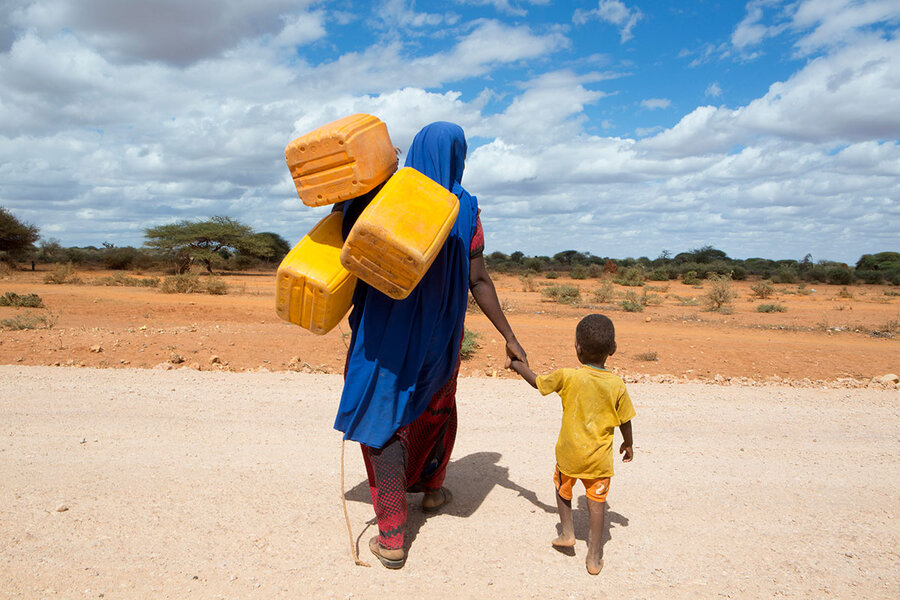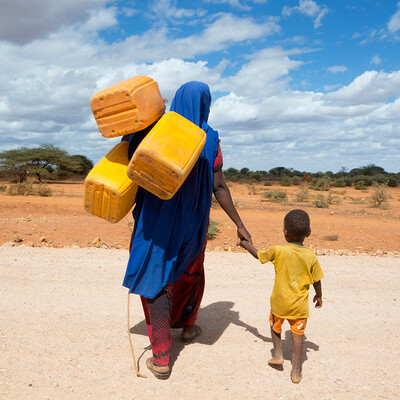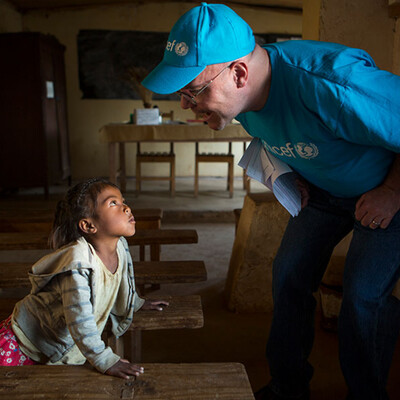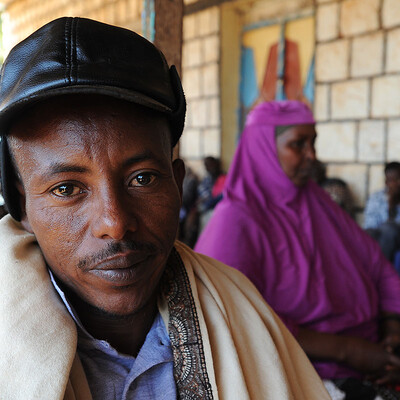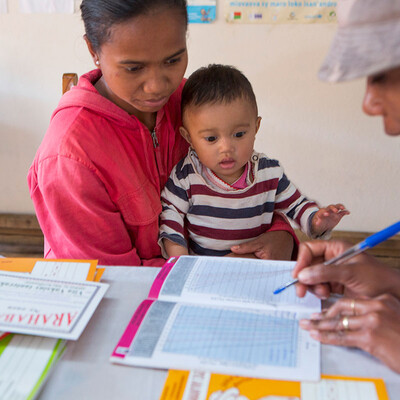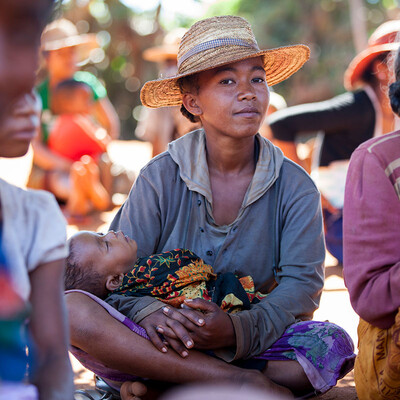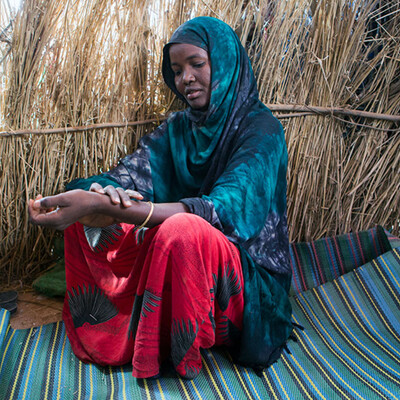Can famine be checked as Africa faces its worst crisis since the 1980s?
Loading...
| Sihanamaro, Madagascar
For as long as she can remember, Vaha Saajinuru, a wiry middle-aged woman with an expressive face, spent much of each day in exhausting drudgery, fetching water. Living on the parched, drought-stricken south coast of Madagascar, she had to make the journey four or five times a day: out of her village, down a cactus-lined dirt road, and across thorny grassland to a muddy water pit more than a mile from her home.
Then she’d walk back again, slowly, so that the water did not spill, a plastic bucket balanced on her head, a jerrycan in one hand and a granddaughter clinging to the other. Sometimes, when things were really bad, she and her family would drink what they call “chocolate water” – whatever they could scoop from potholes in the rust red clay roadway.
“We knew it wasn’t good for our health but we had no choice,” says Ms. Saajinuru.
Now she and her neighbors in Sihanamaro do have a choice as they gird themselves, like millions of others in Africa’s arid zones, to cope better with drought and the threat of famine. With help from UNICEF, they have installed seven community faucets around the village, each set in a cement trough and protected by a picket fence, to provide clean water pumped from a nearby well. “This has changed our lives,” Saajinuru says.
Madagascar’s brush with widespread starvation last year drew little attention from the rest of the world. But over the past 50 years other African countries have come to epitomize the dangers of drought and the tragedy of famine. Today, battered by global warming and civil wars, wide swaths of the continent again face an unprecedented crisis: In Nigeria, South Sudan, Somalia, and across the Red Sea in Yemen, 20 million people face starvation, “barely surviving in the space between malnutrition and death,” in the words of UN Secretary-General António Guterres.
Yet the threat many of these people face today may be less grave than it would have been for their parents and grandparents. Over the past two decades, African nations have learned valuable lessons about how to predict, if not prevent, droughts, and how to ward off famine by strengthening the defenses of the most vulnerable.
From Madagascar to Ethiopia to Somalia and beyond, governments, international aid agencies, and the villagers they help are building up “community resilience.” That’s the new buzzword in humanitarian circles: It is seen as key to ensuring that farmers and herders have something to hold onto when drought strikes, rather than cycling endlessly in and out of disaster.
Resilience is a big concept that works in little ways. It could be a water project such as Sihanamaro’s, ensuring that already malnourished children do not get sicker by drinking polluted water. It could be a public works venture in Ethiopia that pays villagers cash or gives them food to build roads or dig wells. Or it could be an experimental farm in Somaliland encouraging goatherds to diversify into growing food crops.
These initiatives won’t prevent drought, nor will they eliminate famine overnight. But by helping people withstand sudden shocks and contributing to longer-term development goals, they are saving lives.
In the meantime, there is a life in urgent need of saving at an emergency health center in Hargeisa, the capital of Somaliland, a self-governing breakaway region of Somalia in the Horn of Africa. Nabhan Ismail, his eyes sunken and a feeding tube taped to his cheek, turns restlessly on his bed as family members take turns stroking his tiny body. The family made the journey to this center, run by UNICEF and the Somaliland Red Crescent, after waiting seven days to find a ride from their remote area 100 miles away.
“I am thinking about Nabhan’s health and praying to God that he will get better,” says Ismail Ibrahim, the boy’s teary-eyed young father. “I have never heard of a drought that claimed the lives of the livestock and the lives of people.”
He says “countless” children have died recently of hunger and disease in his remote home district 100 miles away. His herd of 100 sheep and goats has been reduced to just six animals.
Mr. Ibrahim is by no means alone. The United Nations warned recently that 6.7 million people are in urgent need of assistance in Somalia; 6 million people are in the same predicament in South Sudan; in Yemen,
7 million people are on the brink of famine.
“We stand at a critical point in history,” UN humanitarian affairs chief Stephen O’Brien told the UN Security Council in March. “Already at the beginning of the year we are facing the largest humanitarian crisis since the creation of the United Nations.” Four months later, the outlook is no less grim.
The crises in South Sudan and Yemen are almost entirely human-caused. They are the result of civil wars in which all sides destroy crops or steal livestock in punitive raids, forcibly confiscate food aid for soldiers’ use, and make it too dangerous for humanitarian workers to go to many areas.
But Ethiopia, Somalia, and Madagascar face a different problem: They are at the sharp end of climate change, which is disrupting rainfall and other weather patterns. The current drought in southeastern Ethiopia follows a dry period in the north, which in turn struck only a few years after the 2011 drought in the Horn of Africa that brought famine to Somalia. It’s a succession of extreme weather events that would have been unthinkable just a generation ago.
“No rain, no water, no pasture, no milk, no food,” laments Halima Gawsole, a thin and muscular herder with hard eyes, listing the chain of misfortunes she has endured since the rains stopped coming in southern Ethiopia a year ago.
Now she and 30 members of her extended family are on the move, trudging down the road through a parched landscape, their last remaining possessions piled on the back of their sole surviving animal, a weary donkey. They had heard the government was handing out water and sacks of grain nearby and had come to see if it was true. “We have lost everything now,” says Ms. Gawsole.
Next door, Somalia is living through a drought that, residents say, is even worse than the one that killed 250,000 in 2011. It has forced hundreds of thousands of people from their grazing lands into makeshift camps with no sanitation, such as one on the outskirts of Burco, a desert town 110 miles east of Hargeisa.
A straggly collection of sticks and rags, the settlement – which residents ironically call “prosperity camp” – offers little protection from the oppressive heat and wind-whipped sand. The only relief is brought by a water truck that comes daily.
“Water is life, but what about food and something to cook it with?” asks Farah Robleh, whose veins stand out on his forehead above his gaunt, gray-stubbled cheeks. He once herded 200 goats and sheep and 20 camels. He has just 20 goats left. “I don’t think anyone can live here anymore,” he sighs. “We have no options. We are only waiting for help.”
In Madagascar, the large island off the southeast coast of Africa, the situation is less grim, but droughts that used to come in cycles are now semipermanent. In 2016 El Niño made the rains even more irregular, “and last year was the worst that I’ve experienced,” says Audin Rabemiandriso, the doctor who runs the health clinic in the dusty, ramshackle coastal town of Ambovombe.
Desperate to buy food, locals first sold their goats. Then they sold their prized humpback cattle. Finally, they sold their kitchen pots. There was nothing to cook, anyway, besides leaves and bitter cactus fruit.
Droughts are inevitable, and likely to strike more often and more harshly because of global warming. But famines are avoidable. It’s a question of doing the right thing. And, critically, of doing the right thing at the right time.
That’s why the UN and aid groups are increasingly unleashing a new weapon in their quest to prevent famine – warning the world early and often. In 2011, when a quarter of a million Somalis died of starvation, half of them had already perished by the time famine was officially declared. It was that tragedy that prompted the UN to sound the alarm in advance, last February, about the current impending disasters.
It worked, sort of. International donors stepped up quickly, and the famine that had been declared in two districts of South Sudan has been beaten back. Elsewhere in the country, though, the situation is worsening and a million more people need immediate aid now than in February.
In Madagascar the world reacted quickly to the creeping food crisis last year because international aid workers had long been present in the country, one of the poorest and least developed places in the world. UNICEF saw that food was growing alarmingly scarce as early as 2015, when government doctors and nutritionists carrying out routine health checks began reporting skyrocketing levels of child malnutrition.
Quickly, the agency expanded its nutrition programs to all 193 town and village health centers in the south, screening every child under age 5 and making sure the most malnourished were given high-nutrition peanut-based food supplements. By and large, they succeeded; few children died.
International agencies “were here, ready to go,” says Elke Wisch, UNICEF director in Madagascar, “and we switched gears into emergency mode in a timely fashion.”
To cope with hunger, aid groups are increasingly trying a novel tactic – handing out cash instead of food. In Yirowe, a drought-stricken village in Somaliland, cash transfers have been instrumental in giving locals the ability to hold out.
The goal is to keep people from leaving their homes and joining the flood of 740,000 internally displaced people who are straining international relief efforts. And it’s working. Not only have all of Yirowe’s 655 families stayed put, but they have welcomed 150 families from the nearby countryside.
Concern Worldwide, an Irish nongovernmental aid group, gave the village’s poorest families $65 a month for three months and double that in April. Cash handouts are an increasingly common way of giving aid in many parts of the world. “Cash allows the flexibility for beneficiaries to make empowered choices about what they need most,” says Erin Wolgamuth, Concern’s regional manager in Somaliland.
“Without this help ... we would not even be at a basic level,” notes Abdirizak Ayah Awad, the head of the village committee that chose the recipient families.
Patricia Soavenira has benefited from cash payments, too. She lives in a cramped, low-roofed thatched hut in Ankilimanara, a tiny village on Madagascar’s parched south coast. Ms. Soavenira is one of 55,000 mothers whose malnourished children make them eligible for a $10 monthly handout from a local nongovernmental organization.
Before the payments, Soavenira had sold everything her family owned except one pot and a spoon. Now she has bought five more spoons and another saucepan. She takes weekly trips to a market an hour’s walk away, where she buys rice, corn, and beans.
“Without the cash, we’d just be eating cassava leaves and wild cactus like last year,” she says.
In some cases, local villagers are appealing directly to individuals. Jamal Abdi Sarman, a senior UNICEF staffer in Hargeisa, is a member of a private WhatsApp group using mobile phones to spirit aid money to hungry Somalis.
“From Australia, from South Africa, from Istanbul and California the money goes into the same [bank] account in Burco,” a town in the heart of drought country, where it is used to buy food for the neediest families, Mr. Sarman says.
A handful of herders first sent out an SOS six months ago when their livestock began to die off. Since then, their WhatsApp group – christened Daryeel, which means “caring” – has gathered $255,000 from fellow clan members and other donors on five continents. It has paid for water trucks and packages of rice, dates, sugar, milk, and oil for nearly 1,000 families in 39 villages. But the benefits have spread much further.
Ununley is a tiny desert community of corrugated tin-roofed homes and rustic stick-frame shelters covered with sheets and blankets in Somalia. A handful of modest shops cling to the paved road that bisects the settlement and disappears into the unforgiving Somali moonscape. Ten families here received a share of the bounty that came in and have, in turn, shared it with their neighbors.
“Almost 100 families did not move because of the help for 10 families,” says Safiya Hassan Ibrahim, who distributes the aid with no-nonsense efficiency.
“The assistance came when we most needed it,” adds one recipient, Mohamed Farah. “It changed our lives – we would have died without it, just like our livestock.”
As much as these initiatives help, relief experts say that more “sustained resilience” programs are needed to prevent people from drifting into despair to begin with. Such efforts can take different forms. In Andahive, a village in southern Madagascar, resilience comes in the shape of a new sweet potato.
Prinu Rakutunirina, a leather-faced local farmer, has always grown sweet potatoes, but the traditional local variety was not ideal: It grew poorly in drought and the tubers went bad within weeks of harvest.
Last year he planted a new, more drought-resistant strain, introduced by agronomists with the UN Food and Agriculture Organization (FAO). But it was no match for the dry weather: Starved of water, the plants withered, twice.
Maybe it was faith or maybe it was desperation, but Mr. Rakutunirina stuck with his experimental variety: He finally brought in a harvest last February.
And what a harvest it was. Yields were double what they used to be, he says, and the new sweet potatoes last for nearly a year. That means he can decide when he wants to sell them. He can also carry his family through the lean season, between harvests, when there is normally nothing to eat.
Rakutunirina was part of a pilot group using the new variety. “Now everyone wants to plant this type,” he says, though it will be a year until the 100,000 farmers using the improved shoots will have harvested enough to spread the variety across the dry south.
“If there is no rain for three months it does not matter how many high-yield seeds you plant,” cautions Jean-Etienne Blanc, an FAO fieldworker. “You’ll get a poor harvest. But farmers are learning about good-quality seeds and how to use them, and next year they will be seeking them out.”
Rural residents across northeastern Africa are also learning how better to conserve water. Consider the case of Mohamed Abdi Madar, a camel herder who roams the scrubland west of Hargeisa. He doesn’t live near a well, but he does now have access to an underground water tank that catches and stores rainwater. It was dug by locals and paid for by Concern.
“Leaving aside the livestock, even the people would start to die without this water,” says Mr. Madar as he pulls up a full bucket to give his two camels.
The concrete-lined tank, 40 feet long by 20 feet across and 10 feet deep, gathers rainwater channeled to it from higher ground and stores it under a sheet of corrugated iron to slow evaporation.
Without the tank, protected from animals by a thick ring of thorn bushes, herders would have been forced to head to a riverbed six miles away. “But we would have gone there only with hope,” says Madar: The riverbed is dry and “we do not have the power or the resources to dig out the water.”
Dependent on the supplies in the tank, Madar and his fellow herders are turning away from their ancestral nomadic lifestyle and taking up agriculture as a new source of sustenance. “It’s not optional, it’s mandatory,” says Mohamed Abdi Yusuf, an elder at another water catchment tank nearby. “Whenever people lose their livestock they start farming.”
Mr. Yusuf has identified a deeper shift that may have to occur if Somalis are to survive recurring droughts – a cultural one. Once upon a time, the camel was “as vital to life as the tendons in one’s back,” as an ancient Somali poet put it, “a living boulder placed by God in the wilderness.”
Today nomadism “is no longer tenable,” says Saad Ali Shire, Somaliland’s foreign minister. Since the 1950s his country’s population has risen sixfold and livestock numbers fourfold, burdening the land beyond what it can bear even when the rains come.
“If we want to keep camels and sheep and goats, then we must change the way we raise them,” Mr. Shire says.
That will mean staying in one place and growing animal feed alongside other crops, such as the vegetables that trainees are about to harvest at the Free Farmer School, 40 miles outside Hargeisa. Young citrus trees, sunflowers, onion, and garlic wave in the breeze. Local elders offer corn and watermelons as gifts to a visitor and emblems of their desire to learn a new lifestyle.
“We gave them seeds and tools to increase their resilience,” says Khaled Taib, a water expert with Concern, which set up the farm. “Now they need some knowledge.”
Modernization and development can help stem starvation as well. This has certainly been the case in Ethiopia, once a poster child for catastrophic famines such as the one that killed more than 400,000 people in 1984. Today, thanks to more than a decade of breathless economic growth, the country’s image is closer to matching that of its capital, Addis Ababa – gleaming, cosmopolitan, and boldly aspirational.
Indeed, Ethiopia has become a regional model for early famine warning and nimble response. This year the country has been plagued by the same drought as next-door South Sudan and Somalia but is experiencing nowhere near the suffering.
The 2015-16 drought in the north of the country “was at least as bad” as the 1984 drought, says Stein Holden, an Ethiopia expert at the Norwegian University of Life Sciences in As, Norway. “But because the country is economically much stronger and more stable now, it has been able to provide a lot of the aid itself, without outside intervention.”
Contributing to Ethiopia’s success: a natural disaster management office that amasses stacks of early warning weather data, and a public works program in the lean season that pays poor Ethiopians in cash or food to build the kind of infrastructure that the country needs – water storage tanks, paved roads, and health posts.
“The system Ethiopia has is spectacular,” says Kelly Johnson, a World Bank social protection expert advising Addis Ababa. “It is beginning to serve as a model for other programs in Africa and around the world.”
Ethiopia’s success story is not a simple one. The country’s one-party government has instituted and maintains a firm grip on journalists and political opponents. Foreign aid workers are careful not to offend their hosts by speaking too openly of problems they find.
But, significantly, drought no longer necessarily means death in Ethiopia.
For other parts of Africa, that is, unfortunately, not the case. Despite the lessons learned about alleviating famine over the past quarter century, droughts still occur. For every relief effort that works, another falls short. Hunger still stalks villages.
But aid workers and local residents are getting better at blunting the effects of drought, saving lives as they do. Amid all the hardship, there are individual moments of triumph, too. Back in the emergency health center in Hargeisa, staffers have been working assiduously to save little Nabhan, the infant with the feeding tube. A week after being admitted to the center, nurses say he is on his way to recovery.
“We think he will survive,” says his joyful grandmother, Ardo Mohamoud. “We are so happy!”




